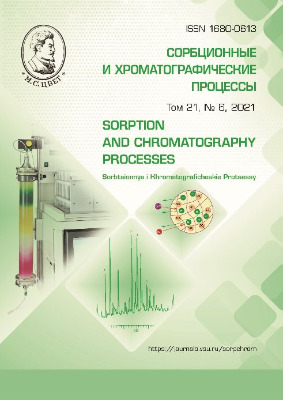Influence of the pore size of Kromasil sorbent on the retention of carotenoids in reverse-phase HPLC
Abstract
The dependence of the retention of three test analytes – lycopene (I), β-carotene (II), and zeaxanthin dipalmitate (III) – on the pore size of three sorbents with the same chemical composition of grafted alkyl (C16) groups was investigated and methods for assessing the effect of pore size on retention were compared. The choice of test compounds was made in a way that in one of the pairs the linear sizes of the molecules were close (for I and II), and for any of these substances, compared with the third component (for example, for III and II), the difference in size would be significant. With an increase in the pore size (from 80 to 160 Å), the specific surface area of the sorbents decreased; therefore, the retention of analytes at the same composition of the mobile phase noticeably decreased. However, for the relative retention for carotenes (I and II) with similar molecular sizes, no significant differences between the logarithms of retention factors were found. In this case, for III, the retention increases with an increase in the pore diameter of the sorbents, which was consistent with the well-known hypothesis that, with an increase in the pore size, the retention of compounds with the size larger than 10% of the pore size should increase. However, for the correct analysis of the change in retention with a change in stationary phases, changes in the phase ratios of the columns should be taken into account. The study proposed two variants of comparison, which take into account the differences in the phase ratios. According to the first variant, the logarithms of the retention factors of the selected analytes on one of the columns were compared with respect to the analogous parameters for the comparison column. In the second variant, the increments – changes in the logarithms of the retention factors for the transitions from II to I and II to III in several compositions of the mobile phases for different columns were compared. In both cases, when the stationary phases for lycopene and β-carotene changed, the dependence of the distribution constants on the pore size was practically absent. However, for the zeaxanthin diester, a decrease in this parameter, confirmed by an analysis of the thermodynamic parameters of the transfer of analytes from the mobile phase to the stationary phase was observed.
Downloads
References
Lee Y.R., Li X., Ma W. et al., Anal. Lett., 2017, Vol. 50, pp. 905-915.
Bagge J., Enmark M., Leśko M. et al., J. Chromatogr. A, 2020, Vol. 1634, 461653.
McCormick T.J., Foley J.P., Riley C.M. et al., Anal. Chem., 2000, Vol. 72, pp. 294-301.
Dai H., Dubin P.L., Andersson T., Anal. Chem., 1998, Vol. 70, pp. 1576-1580.
Godinho J.M., Naese J.A., Toler A.E. et al., J. Chromatogr. A, 2020, Vol. 1634, 461678.
Schuster S.A., Henry R.A., GCLC North America, 2018, Vol. 36, pp. 134-135.
Uppal S., Dergunov S.A., Zhang W. et al., Antioxidants, 2021, Vol. 10, p. 413.
de las Rivas J., Abadia A., Abadia A., Plant Physiol., 1989, Vol. 91, pp. 190-192.
Varzakas T., Kiokias S., Current Res. Nutr. Food Sci., 2016, Vol. 4, pp. 01-14.
Wright S.W., Jeffrey S.W., Mantoura R.F.C. et al., Marine Ecol. Progress Ser., 1991, Vol. 77, pp. 183-186.
Podunavac-Kuzmanović S.O., Jevrić L.R., Tepić A.N. et al., Hem. Ind., 2013, Vol. 67, pp. 933-940.
Dias M.G., Oliveira L., Camões F.G.F.C. et al., J. Chromatogr. A, 2010, Vol. 1217, pp. 3494-3502.
Khachik F., Beecher G.R., Goli M.B., Pure Appl. Chem., 1991, Vol. 63, pp. 71-80.
Marchetti N., Giovannini P.P., Catani M. et al., International J. Anal. Chem., 2019, Vol. 2019, Article ID 7535813.
Emenhiser C., Sander L.C., Schwartz S.J., J. Chromatogr., 1995, Vol. 707, pp. 205-216.
Kishimoto S., Sumitomo K., Yagi M. et al., J. Japan. Soc. Hort. Sci., 2007, Vol. 76, pp. 250-257.
Ligor M., Kováčova J., Gadzała‑Kopciuch R.M. et al., Chroma-tographia, 2014, Vol. 77, pp. 1047-1057.







